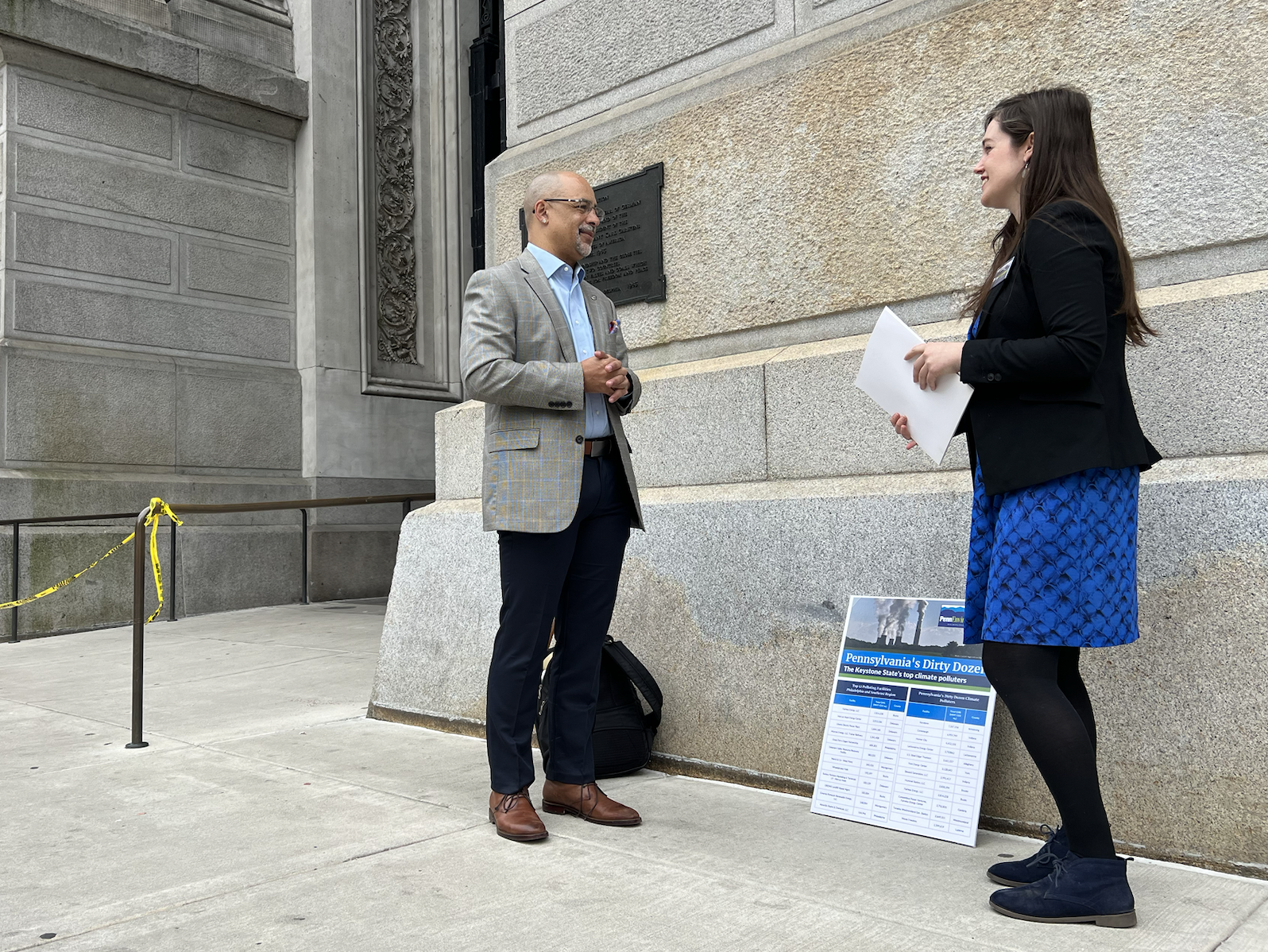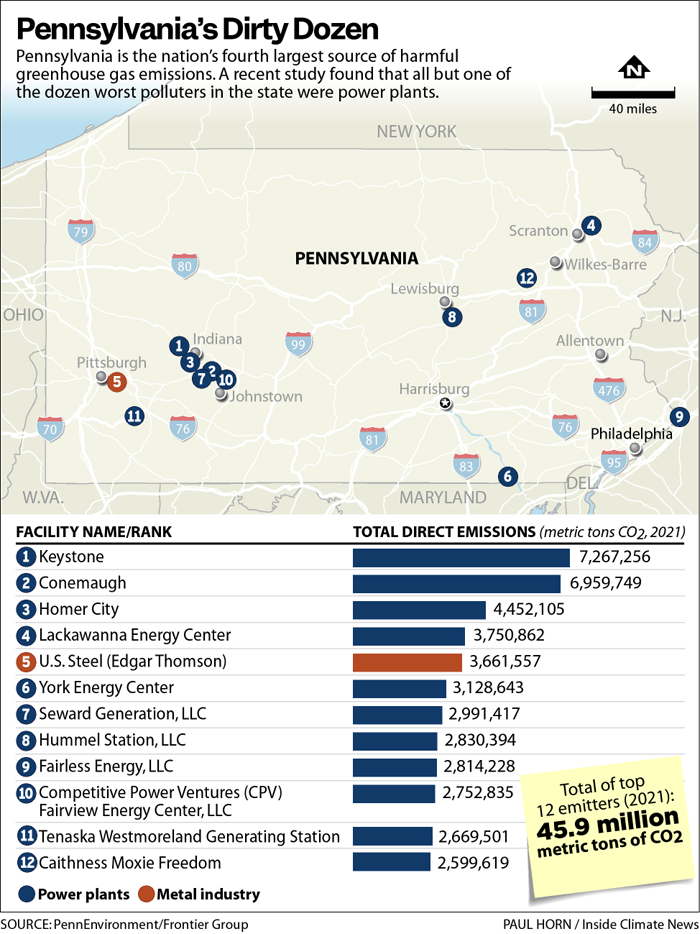
The nation’s first oil well was drilled in 1859 in Titusville, about 100 miles north of Pittsburgh. Eight years before the Declaration of Independence was signed, anthracite coal was being mined in Kingston, about a two-hour drive from Philadelphia. And one of the nation’s oldest oil refineries, long owned by the Atlantic Richfield Co., operated here starting during the Civil War-era until a catastrophic explosion in 2019.
To environmentalists, that legacy is notable for another reason: Pennsylvania has long been home to some of the nation’s worst polluters, and today is the country’s second largest energy producer and among the top five emitters of greenhouse gases.
“We are an outsized part of the problem,” said Stephanie Wein, a water and conservation advocate at PennEnvironment, a Philadelphia-based advocacy group. “That means that anything you do here is an outsized part of a solution. And because it is such a mess, if we get our house in order, it has such a disproportionate impact.”
Wein was speaking last week when her group released a report that identified Pennsylvania’s dozen worst polluters. Two days later, federal officials may have given the state a new tool to straighten up its house when the Environmental Protection Agency proposed new carbon pollution standards for power plants that officials said would prevent about 1,000 premature deaths each year.
The proposal would stem the emission of more than 600 million metric tons of harmful carbon dioxide pollution by 2042. Officials said that figure represented the rough equivalent of the pollution caused by the exhaust from about 137 million passenger vehicles, which is about half the number of cars in use nationwide.
“By proposing new standards for fossil fuel-fired power plants, EPA is delivering on its mission to reduce harmful pollution that threatens people’s health and wellbeing,” EPA Administrator Michael S. Regan said in a statement. “EPA’s proposal relies on proven, readily available technologies to limit carbon pollution and seizes the momentum already underway in the power sector to move toward a cleaner future.”
Federal officials said that from a public health standpoint, in addition to fewer deaths from pollution-related illnesses, the new standards would also result in 800 fewer hospital and emergency room visits; 300,000 fewer asthma attacks; and 66,000 fewer missed days at work each year.
Here in Pennsylvania—with its rich past and fraught present concerning energy production—environmentalists seemed to take particular note of the new proposals and called them a promising first step toward curbing harmful emissions.
“We’re definitely going to see huge reductions in pollution from this rule,” said Flora Cardoni, a field director with PennEnvironment. “A 90 percent reduction by 2030 from coal-fired power plants, which is huge in terms of tackling our climate problem.”
Of the dozen worst polluters in Pennsylvania, all but one were power plants, according to the PennEnvironment study.

The two worst facilities were coal-fired power plants, and five others were gas-fueled power plants that have opened since 2018; the latter, the PennEnvironment report said, illustrates “the limitations of the transition from coal- to gas-fired power generation for reducing climate pollution.”
“Our report this week highlighted that for far too long, Pennsylvania has been a big part of the climate pollution problem,” said Cardoni. She noted that the state produces about 4 percent of the nation’s greenhouse gases and said that the EPA’s proposal could “help make Pennsylvania a part of the solution by reining in some of these polluting power plants.”
Michael Plummer, director of public affairs for the Pennsylvania Chamber of Business and Industry, responded in an email that “Pennsylvania’s transition from coal to natural gas power generation has been extremely effective in the reduction of greenhouse gas emissions.”
Plummer said a Department of Energy report in 2021 concluded that the decline of carbon dioxide emissions between 2005 and 2019 is “attributable to the shift from coal-fired to natural gas-fired electricity generation.”
“As policymakers consider legislative solutions to conserve Pennsylvania’s abundant natural beauty, we encourage state leaders to weigh the significant environmental benefits of Pennsylvania’s transition to natural gas as part of an all-of-the-above energy strategy that keeps us competitive with other states and nations,” he said.
State Rep. Chris Rabb, a Philadelphia Democrat, said ranking the state’s top dozen greenhouse gas emitters is important in understanding the scope of the state’s pollution problem.
“We need to know who is part of the problem,” said Rabb, whose district includes a cluster of neighborhoods along the city’s northern edge. “And we also need to know, based on what the problem is, what are the solutions.”
“The problem is that we have major polluters who are getting away with polluting our air, water, land,” he said. “And many of those polluters are not that far from Philly, and they are hurting us.”
Walter Tsou, a doctor with Physicians for Social Responsibility, an organization that mobilizes medical professionals around issues of equity and social justice, said the report highlights the profound impacts air pollution has on people who are inhaling particulate matter and other toxic substances in their environment.
Tsou, who was the former health commissioner for Philadelphia and the former president of the American Public Health Association, noted that the two largest emitters are coal-power plants. He said burning coal produces particulate matter which can “trigger asthma” and exacerbate chronic obstructive pulmonary disease, emphysema and bronchitis.
He said coal plants also emit mercury that ends up in soil. “We know that it is a neurotoxin and one that has profound impacts, particularly in children, who perhaps they’re playing in the area,” Tsou said.
He added: “We can do better, in fact we must do better in trying to reduce these greenhouse gases.”